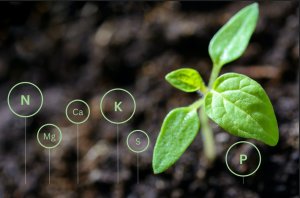Nutrient circularity
It is difficult to imagine feeding the growing population without the use of synthetic fertilisers, but it is also becoming increasingly clear that food production cannot continue to be as reliant on fertilisers as they currently are. A production system that is highly reliant on fertiliser is exposed to high risk and is severely influenced by fertiliser prices.
 Nutrient circularity is a concept which relates to the efficient use and recycling of nutrients in a closed-loop system. It refers to the process of recycling and reusing nutrients within an ecosystem, ensuring that nutrients are returned to the soil or other ecosystems, rather than being lost to the environment. This approach can help to reduce the need for synthetic fertilisers and other inputs, increase resource use efficiency, and support sustainable agricultural and food systems.
Nutrient circularity is a concept which relates to the efficient use and recycling of nutrients in a closed-loop system. It refers to the process of recycling and reusing nutrients within an ecosystem, ensuring that nutrients are returned to the soil or other ecosystems, rather than being lost to the environment. This approach can help to reduce the need for synthetic fertilisers and other inputs, increase resource use efficiency, and support sustainable agricultural and food systems.
Different ways to ensure nutrient circularity
Role of legumes
Legumes play an important role in nutrient circularity because they have the ability to fix atmospheric nitrogen, making it available for plant uptake. This process is facilitated through a symbiotic relationship with bacteria in legume root nodules. The nitrogen fixation process generally allows legumes to thrive in nutrient-poor soils and provides a natural source of fertilisation for other plants. In addition to nitrogen fixation, legumes are also high in protein, fibre, and other essential nutrients such as iron, calcium, and folate. This makes them a valuable source of nutrition for animals and humans alike. Furthermore, legumes are often used in crop rotations, which can help to improve soil health. When legumes are grown in rotation with other crops, they can help to replenish the soil with nitrogen, which can then be used by the subsequent crops, leading to a reduction in synthetic fertiliser needed.
Please visit the following article for more information on legumes: Biological N fixation and legumes
Importance of soil organic matter
 Soil organic matter (SOM) is the organic material found in soil that results from the decomposition of dead plants, animals, and other organic matter. It is a complex mixture of plant and animal residues at various stages of decomposition and includes materials such as leaves, roots, stems, and animal waste. SOM provides a range of benefits to soils, such as improving soil structure, water-holding capacity, and nutrient availability. SOM also acts as a reservoir for nutrients, storing and releasing them as needed by plants. As SOM breaks down, it also releases nutrients like nitrogen, phosphorus, and potassium back into the soil, where they can be used by plants to grow and produce food.
Soil organic matter (SOM) is the organic material found in soil that results from the decomposition of dead plants, animals, and other organic matter. It is a complex mixture of plant and animal residues at various stages of decomposition and includes materials such as leaves, roots, stems, and animal waste. SOM provides a range of benefits to soils, such as improving soil structure, water-holding capacity, and nutrient availability. SOM also acts as a reservoir for nutrients, storing and releasing them as needed by plants. As SOM breaks down, it also releases nutrients like nitrogen, phosphorus, and potassium back into the soil, where they can be used by plants to grow and produce food.
Soil carbon is the carbon component of SOM. When soils have high levels of SOM and soil carbon, they are better able to support healthy plant growth and nutrient cycling through microbial activity. This means that crops can be grown more sustainably, with less dependence on synthetic fertilisers and other inputs. In addition, healthy soils with high carbon levels are more resilient to drought, extreme weather events, and other environmental stresses. By building healthy soils that are rich in SOM and soil carbon, we improve nutrient retention and nutrient turnover, resulting in the creation of a more circular food system that supports environmental health.
Contribution of livestock
Livestock also play a crucial role in nutrient cycling. In particular, pasture-based dairy farming can contribute significantly to nutrient circularity by:
- Utilizing grass as a source of nutrients: In pasture-based dairy farming, cows graze pastures, which are high in essential nutrients such as nitrogen, phosphorus and potassium. As the cows consume the grass, they excrete manure, which is rich in these nutrients.
- Reducing dependence on synthetic fertilizers: By utilising manure, where it is needed, as a source of nutrients, pasture-based dairy farming reduces the need for synthetic fertilisers. Synthetic fertilisers are expensive, and they have negative environmental impacts when applied in excessive quantities. The reduced dependence on fertiliser is a very important risk mitigation strategy ensuring on-farm sustainability in the future.
- Producing high-quality animal-based products: Livestock can create nutritionally valued products (milk and meat) by converting grasslands, which cannot be utilised as a food source by humans. Pasture-based dairy farming can produce high-quality milk products that are rich in essential nutrients such as protein, calcium, and iron. These products can be used to improve human nutrition, closing the nutrient cycle between animals and humans.
Assessing nutrient use efficiency
Further, improving on-farm nutrient use efficiencies will also contribute to nutrient circularity. Trace & Save measures nutrient use efficiency as a ratio of all nutrients exported out of the system to all nutrients imported into the system . High nutrient use efficiencies means that the nutrients are used resourcefully and are not being build-up in the soil or lost to the environment. Nutrient use efficiencies on pasture-based dairy farms are generally very low, due to very high levels of imported nutrients (in animal feed and fertilisers), and low levels being exported off the farm (in milk, animal products and animals removed from the farm). We therefore often see soils with excessive nutrient levels. Dairy farmers can improve their nutrient use efficiencies by implementing proper grazing management, improving the soil health, and increasing the quality of the forage that the cows consume. Improved soil health will result in sustainable soil nutrient cycling and or mineralisation of nutrients that will lead to improved forage quality. Improved forage quality will result in a lower need for imported feed, thereby reducing the amount of nutrients introduced onto the farm. Proper manure management practices can also help to recycle nutrients back into the soil, thus reducing the need for, and reliance on synthetic fertiliser.
Conclusion
In summary, nutrient circularity is a holistic approach to nutrient management that focuses on optimizing the use and reuse of nutrients. It involves the management of nutrients in a way that ensures that they are reused, recycled, or recovered to minimize waste and negative environmental impacts such as loss into water bodies, causing pollution. Nutrient circularity is important to conserve precious resources, to aid in the mitigation of climate change, to increase food security and promote a circular economy, all by supporting sustainable agricultural practices.
